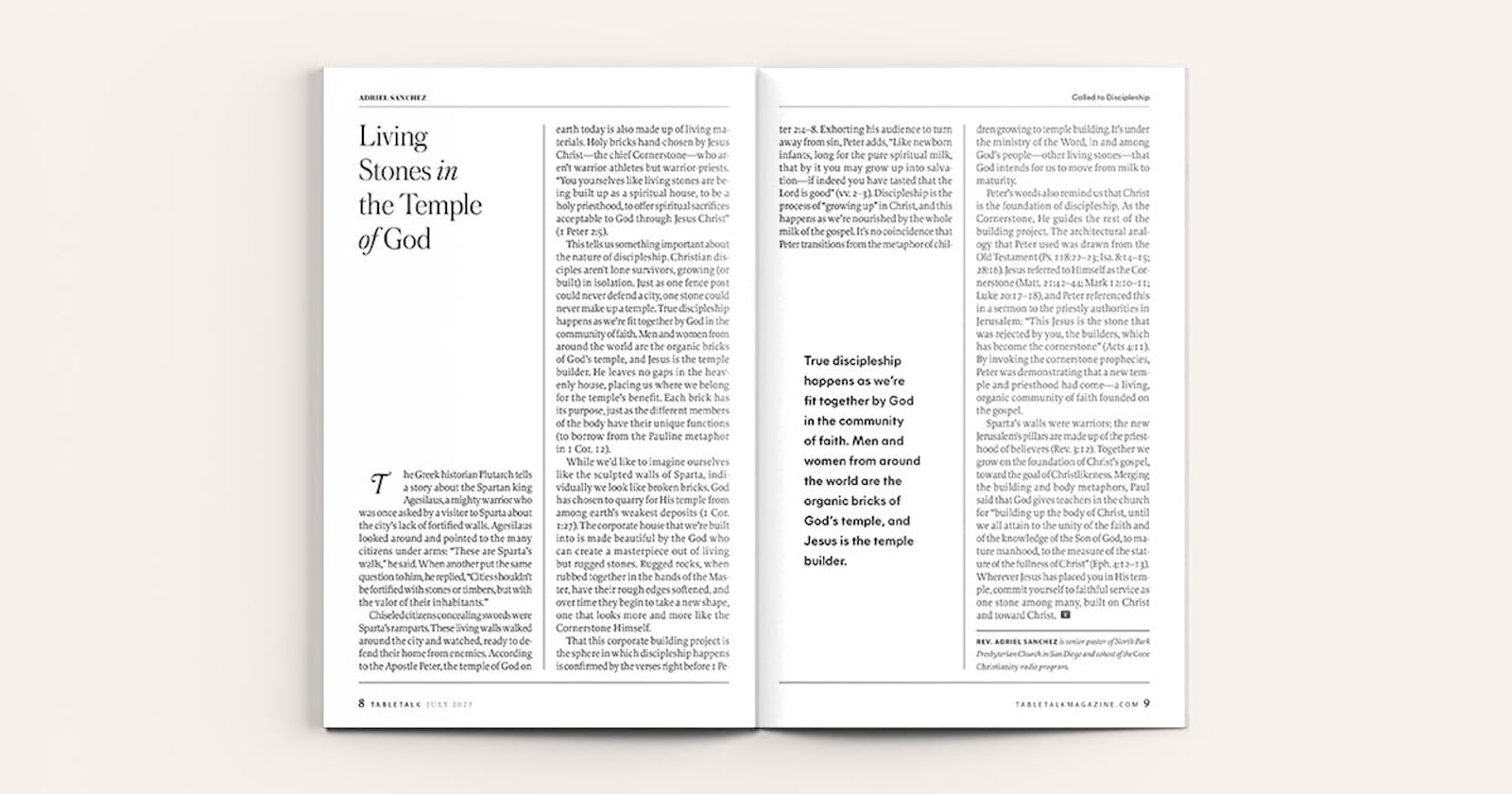
Request your free, three-month trial to Tabletalk magazine. You’ll receive the print issue monthly and gain immediate digital access to decades of archives. This trial is risk-free. No credit card required.
Try Tabletalk NowAlready receive Tabletalk magazine every month?
Verify your email address to gain unlimited access.
The Greek historian Plutarch tells a story about the Spartan king Agesilaus, a mighty warrior who was once asked by a visitor to Sparta about the city’s lack of fortified walls. Agesilaus looked around and pointed to the many citizens under arms: “These are Sparta’s walls,” he said. When another put the same question to him, he replied, “Cities shouldn’t be fortified with stones or timbers, but with the valor of their inhabitants.”
Chiseled citizens concealing swords were Sparta’s ramparts. These living walls walked around the city and watched, ready to defend their home from enemies. According to the Apostle Peter, the temple of God on earth today is also made up of living materials. Holy bricks hand-chosen by Jesus Christ—the chief Cornerstone—who aren’t warrior-athletes but warrior-priests. “You yourselves like living stones are being built up as a spiritual house, to be a holy priesthood, to offer spiritual sacrifices acceptable to God through Jesus Christ” (1 Peter 2:5).
This tells us something important about the nature of discipleship. Christian disciples aren’t lone survivors, growing (or built) in isolation. Just as one fence post could never defend a city, one stone could never make up a temple. True discipleship happens as we’re fit together by God in the community of faith. Men and women from around the world are the organic bricks of God’s temple, and Jesus is the temple builder. He leaves no gaps in the heavenly house, placing us where we belong for the temple’s benefit. Each brick has its purpose, just as the different members of the body have their unique functions (to borrow from the Pauline metaphor in 1 Cor. 12).
While we’d like to imagine ourselves like the sculpted walls of Sparta, individually we look like broken bricks. God has chosen to quarry for His temple from among earth’s weakest deposits (1 Cor. 1:27). The corporate house that we’re built into is made beautiful by the God who can create a masterpiece out of living but rugged stones. Rugged rocks, when rubbed together in the hands of the Master, have their rough edges softened, and over time they begin to take a new shape, one that looks more and more like the Cornerstone Himself.
That this corporate building project is the sphere in which discipleship happens is confirmed by the verses right before 1 Peter 2:4–8. Exhorting his audience to turn away from sin, Peter adds, “Like newborn infants, long for the pure spiritual milk, that by it you may grow up into salvation—if indeed you have tasted that the Lord is good” (vv. 2–3). Discipleship is the process of “growing up” in Christ, and this happens as we’re nourished by the whole milk of the gospel. It’s no coincidence that Peter transitions from the metaphor of children growing to temple building. It’s under the ministry of the Word, in and among God’s people—other living stones—that God intends for us to move from milk to maturity.

Peter’s words also remind us that Christ is the foundation of discipleship. As the Cornerstone, He guides the rest of the building project. The architectural analogy that Peter used was drawn from the Old Testament (Ps. 118:22–23; Isa. 8:14–15; 28:16). Jesus referred to Himself as the Cornerstone (Matt. 21:42–44; Mark 12:10–11; Luke 20:17–18), and Peter referenced this in a sermon to the priestly authorities in Jerusalem: “This Jesus is the stone that was rejected by you, the builders, which has become the cornerstone” (Acts 4:11). By invoking the cornerstone prophecies, Peter was demonstrating that a new temple and priesthood had come—a living, organic community of faith founded on the gospel.
Sparta’s walls were warriors; the new Jerusalem’s pillars are made up of the priesthood of believers (Rev. 3:12). Together we grow on the foundation of Christ’s gospel, toward the goal of Christlikeness. Merging the building and body metaphors, Paul said that God gives teachers in the church for “building up the body of Christ, until we all attain to the unity of the faith and of the knowledge of the Son of God, to mature manhood, to the measure of the stature of the fullness of Christ” (Eph. 4:12–13). Wherever Jesus has placed you in His temple, commit yourself to faithful service as one stone among many, built on Christ and toward Christ.
